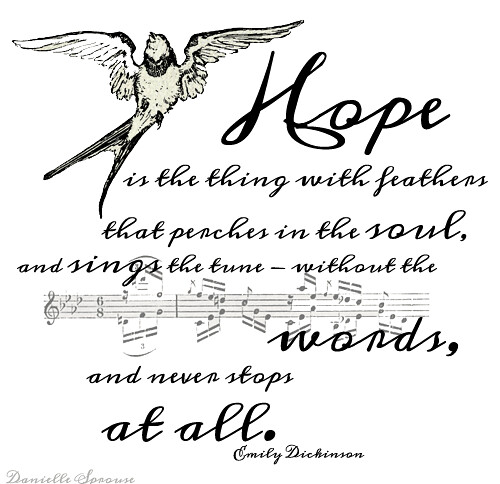“Hope” is the thing with feathers - (314)
 |
| Image created by: Danielle Sprouse |
“Hope” is the thing with feathers -
That perches in the soul -
And sings the tune without the words -
And never stops - at all -
And sweetest - in the Gale - is heard -
And sore must be the storm -
That could abash the little Bird
That kept so many warm -
I’ve heard it in the chillest land -
And on the strangest Sea -
Yet - never - in Extremity,
It asked a crumb - of me.
This poem, makes me feel that no matter how bad things can get, there is still that little grain to light in every situation and even though things may not be working to my advantage, I know that there is still something to be grateful for and something to work even harder towards. This poem is especially inspiring to me because it is accessible and can mean so many different things to many different people. The best thing about Dickinson's work is that it doesn't take an expert to decipher it. You don't have to be an archaeologist to get the meaning. You just have to be willing to take a few seconds or minutes out of your day to read a few lines and simply absorb it. Let it sit in the back of your mind while you go about your day. That's the best way to read and connect with an Emily Dickinson poem. It often seems that thinking too much about a poem drives away the meaning. Try just reading and letting it sink in. Maybe finding a line or two that really strike you even if you aren't sure why. Talk with some friends or a family member. Maybe their view of the same poem is different from yours. It's really interesting how the same few words can have so many different meanings to other people.
To me, Emily Dickinson's work is uplifting and inspires me to be a happier person not only for myself but for those I interact with on a daily basis. This poem, probably one of her more well-known works, imparts to me the wish to help others. Sharing and reading her poetry with others helps to pass this feeling along to a greater audience and I think that was Emily Dickinson's real legacy: to pass along her feelings and emotions to a wider audience. Even though she was barely published, her works have come to mean so much to many people. There are many interpretations of not only this one poem but many of her works. Blow is a video of the Virginia Choral Directors Assn 2012 District XII Middle School SATB Choir's interpretation of this poem.
While it draws on the poem strongly, it also has a voice of its own that can be heard when listened to. This is another great achievement for Dickinson's work. Her words not only look great on paper, but have a profound impact when spoken or even sung. It makes for a happy and uplifting song that listen can get into. Many people can use Dickinson's poetry for inspiration like this choir and Danielle Sprouse, the artist behind the above image did. Dickinson's poetry can be translated into so many different mediums and many different new branches have come from just taking a few minutes to read and feel.
Sources and links:
The Poems of Emily Dickinson Edited by R. W. Franklin (Harvard University Press, 1999)
No comments:
Post a Comment